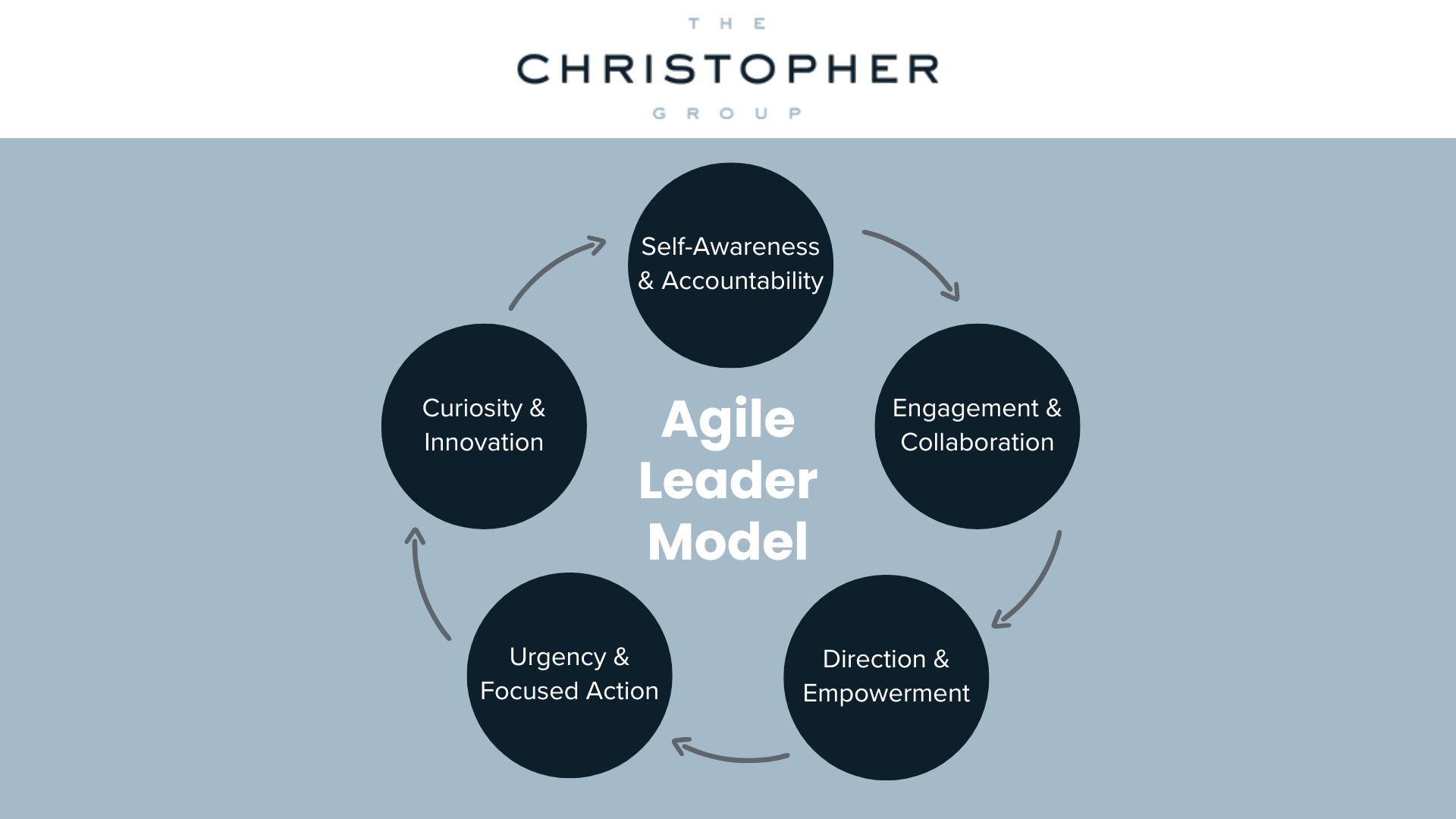In today’s fast-paced and ever-changing business environment, leaders must be able to navigate uncertainty, make quick strategic decisions, and foster innovation. This ability is what sets apart successful leaders from those who struggle to adapt.
Agile leaders don’t just react to change—they anticipate it, drive it, and use it to create organizational agility within their teams and companies.
For senior executives and business leaders, adopting an agile leadership mindset is essential for driving organizational excellence. Companies that embrace agile transformation and organizational change tend to outperform competitors, improve team member engagement, and build strong relationships with key stakeholders.
The Core Components of Leadership Agility
Leadership agility is not just about being flexible. It’s about fostering a leadership style that prioritizes strategic thinking, mutual trust, and innovation. Agile leaders continuously improve their leadership skills and cultivate stakeholder agility, ensuring they can effectively engage with employees, customers, and other key players.
 The Agile Leader Model
The Agile Leader Model
Agile leaders embody specific characteristics that enable them to thrive in uncertainty. These attributes form the foundation of an agile mindset and ensure that leaders can guide their organizations through organizational change while maintaining stability and growth.
1. Self-Awareness and Accountability
At the heart of agile leadership is a deep sense of self-leadership agility—the ability to reflect on one’s decisions, behaviors, and impact on others. Effective leaders take ownership of their actions and remain open to learning and feedback.
Developing leadership competencies in self-awareness helps leaders make informed decisions and adapt their approach when faced with new challenges. By embracing context-setting agility, they can align their leadership vision with their organization’s needs.
2. Engagement and Collaboration
An agile leader doesn’t work in isolation. They actively engage with their team, fostering mutual trust and open communication channels. Successful leaders encourage cross-functional collaboration, ensuring that different perspectives contribute to problem-solving and decision-making.
Building strong relationships within teams helps create an environment where employees feel empowered to share ideas, take initiative, and contribute to business success.
3. Direction and Empowerment
Agile leaders provide clear strategic direction while giving employees the autonomy to execute tasks effectively. Instead of micromanaging, they establish expectations, communicate the bigger picture, and enable teams to take ownership of their work.
By balancing leadership levels within an organization, agile leaders ensure that team members feel confident in making decisions that align with the company’s business strategy.
4. Urgency and Focused Action
In today’s business landscape, delays in decision-making can result in missed opportunities. Agile leaders understand when to act with urgency and when to step back and reassess.
Having a sense of urgency doesn’t mean rushing decisions—it means knowing how to prioritize and take effective action in high-stakes situations. Leaders who master this aspect of leadership agility are better equipped to guide their teams through change and uncertainty.
5. Curiosity and Innovation
The most successful leaders foster a culture of curiosity and continuous learning. They encourage their teams to explore new ways of thinking and solving problems.
By embracing creative agility, leaders create environments where employees feel safe to experiment, take risks, and drive innovation. This mindset not only strengthens a company’s competitive edge but also enhances employee engagement and job satisfaction.
How Leadership Agility Impacts the Organization
When leaders prioritize leadership agility, they create ripple effects throughout the organization. A strong leadership team with an agile mindset contributes to improved company performance, resilience, and organizational development.
Driving Organizational Agility
Organizational agility is the ability of a company to respond quickly to market shifts, industry trends, and internal changes. Agile leaders play a key role in fostering business strategy adaptability and ensuring that teams can pivot when necessary.
Enhancing Organizational Excellence
A business led by agile leaders is more likely to achieve organizational excellence in key performance areas such as efficiency, innovation, and customer satisfaction.
Companies that embrace leadership agility experience the following benefits:
- Higher levels of employee engagement and productivity
- Reduced employee turnover due to strong leadership and company culture
- Stronger relationships between employees and leadership
- Enhanced adaptability to market and economic fluctuations
- More effective leadership development programs that cultivate future leaders
By fostering a culture of agility, businesses position themselves to thrive in an increasingly unpredictable world.
 Hiring Leaders with an Agile Mindset
Hiring Leaders with an Agile Mindset
To build an adaptable and forward-thinking organization, hiring the right leaders is essential.
Identifying Agile Leaders
When evaluating candidates for executive leadership roles, companies must look beyond technical skills and industry experience. They should focus on leadership qualities such as:
- Adaptability: The ability to pivot strategies when needed while staying aligned with long-term business strategy.
- Strategic Thinking: The ability to analyze complex situations and make informed decisions that drive organizational agility.
- Emotional Intelligence: Strong self-awareness and the ability to foster mutual trust within a leadership team.
- Stakeholder Agility: The capacity to build and maintain relationships with key stakeholders while balancing competing priorities.
By prioritizing these qualities in hiring, organizations can ensure they bring in successful leaders who will cultivate agile transformation across all leadership levels.
Evaluating Leadership Competencies
An effective way to assess leadership agility in candidates is by evaluating their ability to:
- Lead during Change: How they have previously navigated uncertain or complex business environments.
- Drive Innovation: Their approach to problem-solving and fostering creative agility within their teams.
- Encourage Collaboration: Their ability to build strong relationships and promote organizational leadership that aligns with the company’s mission.
Recruiting agile leaders ensures that an organization is well-positioned to handle industry shifts and emerging challenges.
Hiring for Future Growth
Companies that focus on hiring agile leaders are investing in long-term success. The business environment is constantly evolving, and organizations need leaders who can navigate uncertainty, adapt their leadership style, and drive effective action.
By prioritizing leadership agility in recruitment, businesses can:
- Build resilient teams that thrive in organizational change.
- Develop leadership pipelines that sustain growth and innovation.
- Strengthen their competitive advantage in dynamic markets.
 The Christopher Group: Identifying the Right Leaders with a Leadership Agility Mindset
The Christopher Group: Identifying the Right Leaders with a Leadership Agility Mindset
At The Christopher Group, we specialize in finding and placing senior executives who embody leadership agility and drive organizational excellence.
Our Expertise in HR Executive Search
Our executive search process is tailored to identify leaders who demonstrate agile leadership in action. We go beyond traditional hiring criteria to assess context-setting agility, self-leadership agility, and creative agility—ensuring our clients receive leaders who can navigate complexity with confidence.
In addition to executive search, The Christopher Group offers advisory services that help organizations cultivate leadership agility within their existing teams. Our customized leadership development and training programs empower organizations to strengthen organizational agility at all levels.
Building Diverse Leadership Teams
Agility thrives in environments that embrace diverse perspectives. Our focus on inclusive executive search ensures that businesses benefit from leaders with varied experiences, backgrounds, and insights. This enhances team member engagement and fosters a culture of innovation.
Partner with Us to Build an Agile Leadership Team
The right leaders make all the difference in a company’s ability to thrive. Whether you’re seeking agile transformation, developing a leadership team, or preparing for future challenges, The Christopher Group is here to help.
Schedule a free consultation today to discover how we can connect you with top-tier leaders who will drive your organization’s success.

